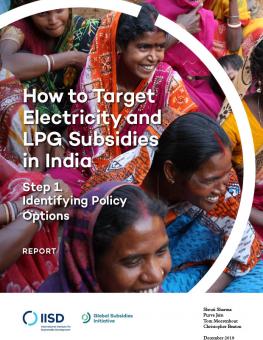
How to Target Electricity and LPG Subsidies in India: Step 1. Identifying Policy Options
This report identifies knowledge gaps that are limiting policy making for better targeting of energy access subsidies in India. It identifies a number of targeting interventions that could be employed to better target subsidies for electricity and LPG.
-
#India’s #energy access policies have achieved almost universal electricity access and a massive uptake in clean cooking—but the policies are also costly. In 2017, electricity and LPG consumption subsidies alone cost INR 87,830 crore.
-
Major knowledge gaps are limiting better targeting of #energy access subsidies in #India. The latest analyses of how benefits of subsidies are shared across different income groups are based on 2011 census data—now significantly dated.
Key Messages
- Major gaps in knowledge are limiting better targeting of energy access subsidies in India. The latest distributional analyses of energy consumption subsidies—that is, how benefits are shared across different income groups—are based on 2011 census data that are now significantly dated.
- This report identifies a number of specific targeting interventions that could better target energy subsidies. It calls for dedicated research to estimate the distributional performance of existing subsidies and various targeting options in order to better inform policy design.
India’s energy access policies have succeeded in achieving almost universal electricity access and a massive uptake in clean cooking. Connection and consumption subsidies for electricity and liquefied petroleum gas (LPG) have played an important role in driving these changes. But the policies are also costly: in 2017, electricity and LPG consumption subsidies alone cost INR 87,830 crore (USD 13.1 billion).
Efforts have been ongoing for years to reduce costs by better targeting subsidies. Most recently, this includes discussions around a Direct Benefits Transfer for Power (DBT-P) for electricity and a possible “Ujjwala 2.0” for LPG. In many cases, however, knowledge gaps are limiting evidence-based decision-making. The last distributional analysis of energy consumption subsidies—that is, how benefits are shared across different income groups—is based on the 2011 census. It is also unclear who would be included or excluded under different targeting approaches.
This report calls for dedicated research on targeting energy subsidies to better inform policy. This includes data collection and analysis in the following areas:
- Estimating the distributional performance of existing subsidies.
- Identifying and evaluating targeting interventions. Based on a review of options, this paper recommends that this should include:
- Opt-out schemes
- Quota-based and volumetric targeting
- Categorical targeting
- Income-, asset- and consumption-based targeting, including related proxies.
- Evaluating opt-in schemes.
- Exploring how basic income transfers affect energy consumption.
You might also be interested in
Gender and Fossil Fuel Subsidy Reform in India: Findings and recommendations
The report examines the impacts of India’s subsidies to cooking gas—and their reform—from a gender perspective. It explores how liquified petroleum gas (LPG) subsidy policies and their reform affect women and girls in low-income households.
Mapping India's Energy Subsidies 2020: Fossil fuels, renewables and electric vehicles
How have India’s energy subsidy policies changed? What have been the most significant developments in India’s dynamic energy policy environment? And is public support aligned with India’s desired energy future?
Part 1 – How Can India’s Energy Sector Recover Sustainably from COVID-19?
From IISD and CEEW, Part 1 of a three-part commentary series takes a deep dive into how India’s energy sector is coping with the impacts of COVID-19 and what this means for the sustainable energy transition.
Rethinking Eskom: Lessons from electricity sector reform in India and Mexico
As South Africa debates how to reform its struggling electricity sector, this publication reviews how international experience from India and Mexico could inform the debate.